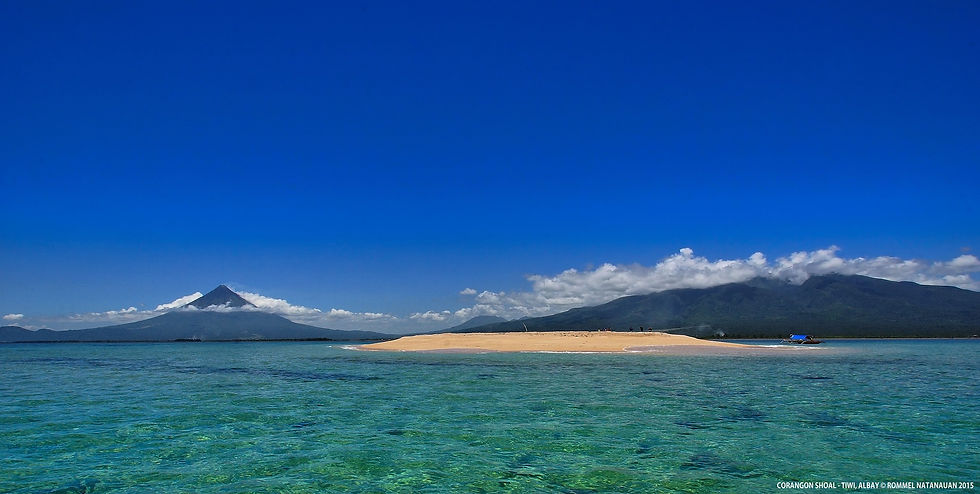Tiwi, Albay Etymology
- Jack Maico
- Jul 23
- 3 min read

Originally named Tigbi by the Spanish colonizers, this quaint little town was once a barrio of Malinao, Albay, in the late 1600s. The town took its name from the Bikolano term for a taro-like plant called tigbi that grew abundantly in the area. The name was then shortened to simply Tibi.
However, the Spanish changed the name to Tivi because they were unable to pronounce the name correctly. After becoming a fully recognized town in 1696, the name Tivi was finally changed to Tiwi.
Legend has it that long before the establishment of the municipality by the Spaniards, the hills of Bolo and Putsan formed a small islet. A volcanic eruption from the now dormant Mount Malinao filled up the part of the ocean that connected the hills of Bolo and Putsan with the mainland of Luzon. This new landmass formed the lands where the Poblacion, Libjo, Cararayan, and Naga now stand. There is a lack of geologic data to prove this legend, apart from extracted sand from the geothermal drillings in the barangay of Cale and the current sea level of Tiwi.
Special credits: https://pbs.twimg.com/media/E2hkhNGVoAQDziH.jpg:large
Church in town: 𝐒𝐭. 𝐋𝐚𝐰𝐫𝐞𝐧𝐜𝐞 𝐭𝐡𝐞 𝐌𝐚𝐫𝐭𝐲𝐫 𝐏𝐚𝐫𝐢𝐬𝐡


The church was originally built near the sea as this was the trade centre of Tiwi, with the doors facing the sea as required by Spanish Laws of the Indies Legislation. The Church of St.Lawrence, Tiwi, was built with stones and volcanic rocks.
Supporting the walls from the outside were Buttresses, which also gave support in case of an earthquake. The remains of the bell tower can still be seen on the left side of the main portal. There are remains of a stone staircase leading up to the bell tower from the outside. Inside the bell tower, there are also the remains of a stone staircase.
Sadly, though, Banyan roots are slowly taking over and growing up the inside walls of the bell tower. The site was not very well protected from the annual raids of Moro pirates, so a new church was built further inland in 1829.
The old church was burned and destroyed by Moro pirates in 1846. The new Church of St.Lawrence, Tiwi, was completed around 1863. The Church ruins are now known as Sinimbahanan.
𝐍𝐨𝐭𝐚𝐛𝐥𝐞 𝐓𝐢𝐰𝐢 𝐡𝐢𝐬𝐭𝐨𝐫𝐲
Tiwi began as a barrio of Malinao before it was formally organized as a politically independent pueblo in 1696. As a pueblo, it was governed by a gobernadorcillo. As a Catholic parish, it was administered by a secular priest under the then Diocese of Nueva Caceres, now an archdiocese. In its primeval stages, it had some 1,105 houses, a parish church, a community-funded primary school, and a cemetery outside the town proper. The villagers ordinarily engaged in fishing, planting rice, corn, sugarcane, indigo, fruit-bearing trees, and vegetables. Aside from agriculture, they also busied themselves weaving cotton and abaca clothes, and in pottery
𝐏𝐥𝐚𝐜𝐞𝐬 𝐭𝐨 𝐬𝐞𝐞 𝐢𝐧 𝐓𝐢𝐰𝐢:

- St Lawrence the Martyr Parish
- Diocesan Shrine and Parish of Our Lady of Salvation
- Mount Malinao
- Corangon Island
- Tiwi Beach
- Bugsokan Falls
𝐅𝐚𝐦𝐨𝐮𝐬 𝐧𝐚𝐭𝐢𝐨𝐧𝐚𝐥 𝐡𝐞𝐫𝐨𝐞𝐬 𝐛𝐨𝐫𝐧 𝐢𝐧 𝐓𝐢𝐰𝐢:
- Zeus Atayza Salazar (a Filipino historian, anthropologist, and philosopher of history, best known for pioneering an emic perspective in Philippine history called Pantayong Pananaw (The "We" Perspective), earning him the title "Father of New Philippine Historiography." He is a major player in the indigenization campaign in the Philippines. Salazar spent 30 years teaching at University of the Philippines Diliman and held both history department chair and college dean positions.)
𝐏𝐢𝐧𝐨𝐲 𝐜𝐞𝐥𝐞𝐛𝐫𝐢𝐭𝐢𝐞𝐬, 𝐤𝐧𝐨𝐰𝐧 𝐩𝐞𝐫𝐬𝐨𝐧𝐚𝐥𝐢𝐭𝐢𝐞𝐬 𝐢𝐧 𝐓𝐢𝐰𝐢:
- Aida Cirujales (retired Bicolana public school teacher, writer of tigsik, poem, poetic debate, Bikol debate, oration, and songwriter.)



Comments